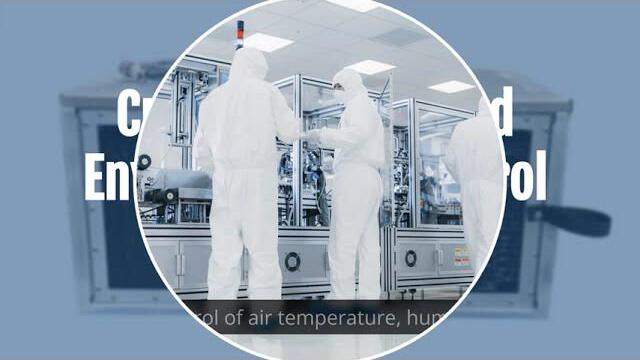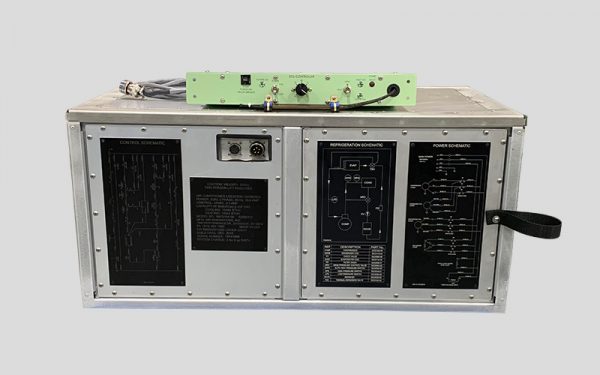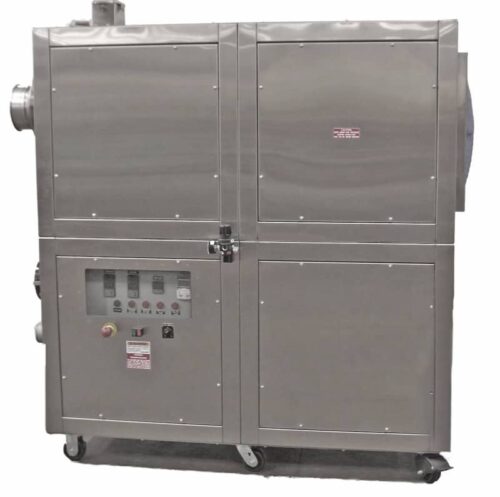Produced by: GlobalSpec
The precise control of air temperature, humidity, particulate levels, pressure and flow rate is critical for the manufacturing and operation of many applications in the semiconductor, aerospace, defense, biomedical and pharmaceutical industries. These are enabled by environmental control systems, which come in various forms and sizes, ranging from relatively small rack-mounted electronic modules to relatively large clean rooms. Because every situation is different, there are very few “plug and play” systems and solutions available on the market that will ideally suit the specific needs of the various applications. This is especially true for first-of-its-kind systems that are being developed to address new or evolving capabilities and technologies. As a result, many of these environmental control systems must be custom engineered. This article reviews some of the challenges of the custom-engineering process, and how Air Innovations can assist customers in developing and optimizing environmental control systems and solutions for their specific applications.
Environmental control system components
Environmental control systems enable the real-time monitoring and control of several environmental variables, such as the level of airborne contaminants, air temperature, humidity, pressure or flow rate. This is usually accomplished with several different components:
Particulate control
Airborne particulates, such as dust, pollen and mold can contaminate the manufacturing process for electronics and pharmaceuticals, or they may disrupt the operation of sensitive electro-optical components. Air cleanliness levels are tested, monitored and controlled according to ISO 14644 standards. High efficiency particulate air (HEPA) filters, which are a type of pleated passive mechanical air filter, remove at least 99.97% of airborne particles with a minimum size of 0.3 microns or greater for the lowest grade HEPA. ULPA (Ultra-Low Particulate Air) remove at least 99.9997% at 0.12 micron or greater. The level of particulate contamination must be measured periodically so the filters can be replaced as needed. Lastly, the amount of clean air that is circulated throughout the enclosure — and how it is distributed — are critical functions of the cleanliness achieved and is a primary focus during the design phase.
Temperature and humidity control
Thermal gradients and moisture in the air may disrupt the operation of sensitive electro-optical components, or result in contamination, such as moisture condensation, water absorption or microbial growth. The control of temperature and humidity typically go together, as the air temperature determines the percent (%RH) of moisture in the air at a given atmospheric pressure. Temperature and humidity control systems require the use of components that are found in standard refrigeration systems, although augmented with highly accurate sensors and control systems, capable of controlling the temperature and humidity within fine limits.
Air pressure and flow control
Environmental control systems clean the air and provide temperature and humidity control by passing or changing the air within the controlled environment several times per hour. It is usually desirable to have a positive (higher) air pressure inside a clean environment so as not to suck in potential contaminants or otherwise un-conditioned air from the external environment through air leaks or open doors. However, in some cases, it may be desirable to create negative or neutral pressure. Air handling units are usually equipped with high capacity fans that can create the desired pressure profile and provide clean, filtered and conditioned outside “make up” air. Air turbulence may also contribute to unwanted thermal gradients or particulate contamination, so many of these air handling units must also be capable of producing laminar air flow within the controlled environment.
Microbial control
Airborne bacteria and molds may contaminate sensitive medical or pharmaceutical manufacturing environments, causing a hazard to consumers. Some environmental control systems that require the flow of sterilized or disinfected air may incorporate ultraviolet germicidal irradiation (UVGI), which is effective in killing or inactivating microorganisms.
An effective environmental control system, regardless of whether it is developed on a relatively small or large scale, must be capable of balancing the control of particulates, temperature, humidity, air pressure and flow rate. A non-optimum system may introduce particulates or contamination into the clean environment, cause wide temperature or humidity swings, create excessive air turbulence or promote the growth of microorganisms. The environmental control system designer must select and implement an optimum set of components to achieve the desired results.
Considerations in environmental control system design process
This section lists a variety of current and future considerations and provides a general “how to” for specifying the design of an environmental control system. While not all of these items may be relevant to the reader’s specific application, they are provided in order to illustrate the potential complexities that may be encountered in the design and development process.
Size and shape of control volume
Does the environmental control system need to be implemented on a certain component, on an entire machine, a manufacturing line or an entire room? Allowance must also be given to the size and placement of the environmental control system components, including fans, filters, heat exchangers, sensors and enclosures.
Equipment and personnel
What are the characteristics of the equipment or personnel operating within the control volume? These may include the following:
- What is the amount of power consumed or generated by internal equipment? (Watts)
- Are there fluids or chemical reactions that generate water or chemical vapors?
- Do moving mechanical assemblies or equipment (such as motors, bearings or slides) create airborne particles?
- Are personnel or equipment from the outside introduced into the control volume?
- Does the internal equipment require open doors during operation?
Internal environment
What is the desired environment within the control volume? This may include the following:
- Atmosphere — Air, nitrogen, inert gas or combustible
- Particulate class (count per unit volume) and size (microns)
- Target temperature (degrees), temperature range (± degrees) and control accuracy (degree change per minute)
- Target humidity (% RH), humidity range (± % RH) and control accuracy (% RH change per minute)
- Air flow rate (volume per minute) and air pressure (wg)
External environment
What are the environment extremes in which the controlled volume will operate? These may include the following:
- Presence of excessive dust, dirt, humidity or precipitation
- Ambient temperature range (degrees)
- Ambient humidity range (% RH)
- Operation in direct sunlight (solar heating), corrosive or volatile environments.
Special considerations
These may include the following:
- Explosion-proof components or enclosures
- Ruggedization for operation in high shock or vibration environments
- Microbial control
- Required use of qualified components (e.g., ETL, UL, CSA, CE, CCC, SEMI, MIL-STD)
- Fail-safe/redundancy
- Size and shape limitations
These and other requirements are used by the environmental control system designer to develop a system design and conduct trade-off studies. These studies then determine the required air flow rate (cubic feet per minute), the sizing and placement of system components (e.g., fans, heat exchangers, ducts and filters), enclosure and insulation requirements, the placement of sensors, and air flow characteristics (e.g., volume flow rate, laminar versus turbulent flow, once-through versus recirculating air). Prototypes of the environmental control system are then fabricated and tested to verify that it meets or exceeds these requirements.
Example applications
Air Innovations has worked with many customers in several different industries to overcome unique challenges and develop customized environmental control systems that are optimized to address their requirements. Examples include the following:
Example 1
A military vehicle application utilized decades-old environmental control technology that fit into a limited space and required upgrading. Air Innovations retrofitted the existing vehicles with upgraded environmental control systems that enabled them to operate in rugged environments over a wider temperature range while allowing the application to fit within its limited space.
Example 2
A pharmaceutical application required tight temperature and humidity control during the mixing of potentially explosive chemicals and powders. Air Innovations developed an environmental control system using once-through air that was intrinsically safe for explosive environments.
Example 3
An oil and gas company required equipment to operate over a very wide temperature range (-40° F to 130° F) while maintaining uninterrupted integration with their communications systems. Air Innovations developed an environmental control system that enabled the equipment to continuously operate within a harsh salt and dust environment with high reliability over the required temperature range.
Example 4
Air Innovations designed, developed and produced an environmental control system for the world’s largest observation wheel, which required a complex-shaped environmental control unit. This system was designed with high reliability, quick serviceability and system redundancy to address potentially life-threatening conditions in the event of power outages or system failure.
Other examples and case studies can be found in the Air Innovations Case Studies section.
Air Innovations overview
Air Innovations was founded in 1986 in Syracuse, New York, and is a world leader in designing and building environmental process control systems. Their primary business involves the development of customized packaged systems and solutions for temperature, humidity, filtration, pressurization and with direct-expansion, chilled-water or thermoelectric capabilities. Our experience covers aerospace, military, pharmaceuticals, photonics, biotech, healthcare, oil and gas, observation wheels, a wide variety of cleanrooms, semiconductor, wine cellars, agriculture, research, life sciences, floral, homeland security, precious goods storage (artwork, fur, instruments) and dentistry. Over 20% of the staff have engineering degrees, and the company maintains a research and development department dedicated to continuous growth and improvement in the creation, testing and validation of their custom-engineered solutions. Air Innovations’ numerous products currently span a variety of industries in over 55 countries. More information about the company and products can be found in the About section.






